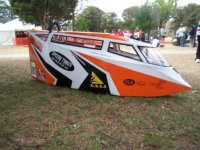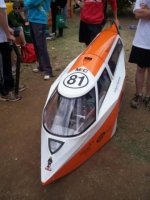coln72
10 W
G'day all,
This is my first post so be gentle I guess this is the right area to post.
I guess this is the right area to post.
Thought I would give a brief run down of the trike that I am currently working on. It is a electric/petrol hybrid designed to compete in a 24hr race against other schools. The event is the RACV Energy Breakthrough racvenergybreakthrough.net and we are competing under the following restrictions:
3 litres of fuel for the event either to use in a petrol motor or generator or both
restrictions on the amount of batteries we can use eg. 100kg of lead acids down to 30kg of lithiums
no mains power to recharge batteries
only "riders" (max of 8) can recharge batteries.
We are using a 300W motor driving the freewheel that I found at school with two 12V 18Ah batteries to give 24V and a 31cc petrol motor to use a friction drive on the tyre.
Currently we have half a frame built with both motors attatched, a mock up of the seat and a controller roughly fitted.
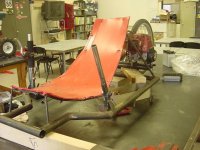
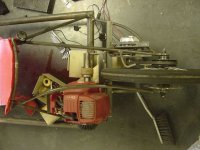
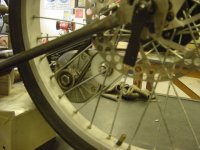
Thes photos show a belt drive which has been abandoned for the moment due to the difficulty of dropping the speed to a sane level (120km/h unloaded was a little high). Have changed to a chain drive so I can easily change gearing. May revert to the belt drive if I can find/make suitable pulleys.
Will post up more pics and reports in the future. If anyone has ideas, questions or criticisms feel free to post them.
This is my first post so be gentle
Thought I would give a brief run down of the trike that I am currently working on. It is a electric/petrol hybrid designed to compete in a 24hr race against other schools. The event is the RACV Energy Breakthrough racvenergybreakthrough.net and we are competing under the following restrictions:
3 litres of fuel for the event either to use in a petrol motor or generator or both
restrictions on the amount of batteries we can use eg. 100kg of lead acids down to 30kg of lithiums
no mains power to recharge batteries
only "riders" (max of 8) can recharge batteries.
We are using a 300W motor driving the freewheel that I found at school with two 12V 18Ah batteries to give 24V and a 31cc petrol motor to use a friction drive on the tyre.
Currently we have half a frame built with both motors attatched, a mock up of the seat and a controller roughly fitted.



Thes photos show a belt drive which has been abandoned for the moment due to the difficulty of dropping the speed to a sane level (120km/h unloaded was a little high). Have changed to a chain drive so I can easily change gearing. May revert to the belt drive if I can find/make suitable pulleys.
Will post up more pics and reports in the future. If anyone has ideas, questions or criticisms feel free to post them.



